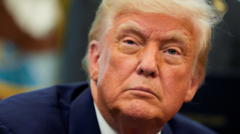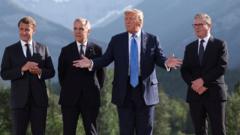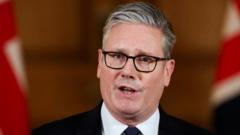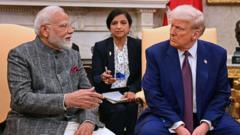US President Donald Trump's announcement of a potential mediation on Kashmir has put India in a difficult position, challenging its long-held policy against third-party involvement in the dispute with Pakistan. The reaction from Indian officials suggests that any US-brokered solutions could face strong internal opposition, complicating diplomatic relations.
Trump's Mediation Proposal on Kashmir Challenges India's Stance

Trump's Mediation Proposal on Kashmir Challenges India's Stance
President Trump's recent mediation offer has raised alarms in India, igniting domestic criticism and complicating the fraught India-Pakistan relationship over Kashmir.
In a surprising twist this weekend, US President Donald Trump proposed mediation between India and Pakistan regarding the long-standing Kashmir conflict, a move that has stirred controversy in New Delhi. The announcement comes after a series of violent exchanges between the nuclear-armed neighbors, prompting an urgent need for de-escalation efforts from the international arena. Trump declared on social media that both nations had reached a "full and immediate ceasefire," facilitated by US intervention.
The Kashmir debate itself traces its origins back to 1947, following India's independence from British colonial rule and the subsequent partition that established Pakistan. Both countries lay claim to the Kashmir region, controlling portions of it but remaining at odds over its entirety. This rivalry has seen countless rounds of talks yielding little in the way of resolution.
Tensions erupted recently after India's air strikes in response to a deadly attack on tourists that India attributes to Pakistan-supported militants. The resulting military escalation saw the deployment of jets and missiles across the border, igniting fears of an extensive conflict. Trump's more unconventional diplomatic approach has thus elicited mixed reactions, particularly against the backdrop of India's historical rejection of foreign mediation in the matter.
Shyam Saran, a former Indian foreign secretary, conveyed the sentiment of many within the Indian government, stating that Trump's proposals are unlikely to be welcomed. India has been particularly adamant about maintaining Kashmir as an integral part of its territory, dismissing any possibility of negotiations under third-party facilitation. The government's strong stance has been reinforced since the revocation of Jammu and Kashmir's special status in 2019—a decision that stirred significant unrest in the region.
The growing apprehension within India mirrors the response from opposition parties, such as the Congress party, which is demanding clarity from the government regarding the implications of Trump's mediation offer. Their growingly vocal stance suggests the fracturing of support for Modi’s administration should third-party involvement become a serious consideration.
Meanwhile, the perspective from Pakistan is markedly different, as they have long advocated for international mediation to resolve the Kashmir issue—viewing this recent development as a potential diplomatic breakthrough. Several experts from Pakistan have argued that the dire need for trust-building initiatives necessitates US intervention, suggesting that the international community has a crucial role in fostering stability and preventing further conflict.
As discussions continue, India's diplomatic balancing act becomes increasingly complex. While seeking to uphold its long-established positions, it remains aware of the key trading relationship it has with the US—a partnership that has grown considerably in recent years. With ongoing negotiations for a trade deal with Washington, India is in a precarious position, where any shift toward accepting external mediation for Kashmir could face vehement domestic opposition and risk destabilizing its international relations.
Ultimately, as the situation unfolds, the implications of Trump's mediation offer will require careful navigation by India, balancing national interests and relationships both locally and globally in the shifting geopolitical landscape.





















